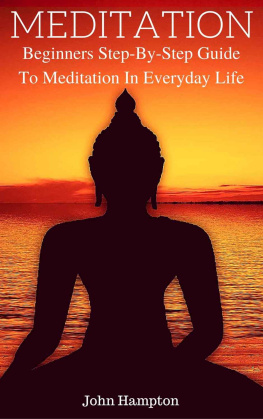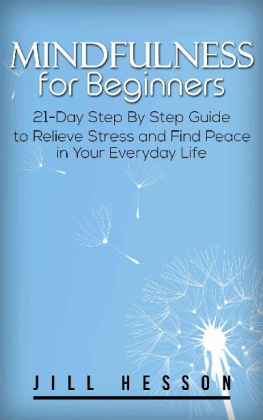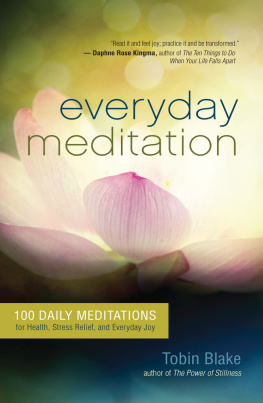A Beginne r s Step-By-Step Guide To Meditation
Introduction
I want to thank you and congratulate you for downloading the book A Beginne r s Step-By-Step Guide To Meditatio n . This Ebook will help you discover the roots of meditation, giving you a necessary overview of how meditation came about within western and eastern cultures. It will gently introduce you to the art of breathing, and how to use breath to cultivate a meaningful meditation experience. Mindfulness, an increasingly popular concept within recent years, is thoroughly explored in order to improve various elements of every day life. Visualisations, the use of colour, sound therapies and mantras are also investigated and explained, preparing you to sufficiently and safely experiment with a wide range of options, with a focus on customising the meditative journey to your own specific needs.
Thanks again for downloading this book, I hope you enjoy it!

Chapter One Meditation, A Brief History
Before we begin to explore the process of meditating, it's good to have an overview of where it comes from, how it has developed within eastern and western cultures, and the influences behind the practise.
A good way of identifying some early human patterns and behaviours is by looking at art and wall paintings. In the Indus Valley, archaeologists discovered painted images portraying meditation dating from as early as 5,000 BC. The images show people sitting in meditation postures, with crossed legs, closed eyes and hands resting on their knees. In terms of written documentation on meditation, Indian scriptures have been found dating back 3000 years that describe the process and techniques.
As the centuries passed by, many of the worlds main religions began to adopt the basics of meditation and it has become one of the most important components within spiritual development.
It is believed that the Hindus were the first to fully embrace meditation, but between 600-500 BC, the practise was recorded in Taoist China and Buddhism within India. This, over time, spread to other cultures in the West and influenced religions such as Judaism and, eventually, Christianity.
The word meditate actually comes from the Latin word meditatum, which means, to ponder. This really does underpin the soul of meditation and it's universal purpose across all faiths.
Meditation was introduced to the United States early in the 20th century, and in the 1960s there was a significant increase in interest.
In Judaism, Kabala has become hugely popular, and this in a nutshell is a meditative study. Islam discusses meditation also. The Quran refers to it as Tafakkur which is contemplative reflection upon the universe. Buddhism is likely the largest investor in meditative practise, and can include Zen, Tibetan and Theravadan approaches in order to achieve enlightenment. Christianity isn't so commonly associated with the method, yet is actually quite prominent within the religion. Scholars point out statements in the Old Testament that read, Be still and know that I am God. Many interpret this as the importance of quieting the mind.
One of the biggest names associated with meditation is the Buddha. The Buddha is known for his amazing journey, which started in superficiality and riches, and progressed through fasting, solitude, meditation and inner exploration to achieve enlightenment. He developed a strong following, focussing on the self rather than a God or supernatural influence. He taught followers to look within rather than outwards.
As the West began to adopt the techniques from a variety of religious sources, the impact it had on health and wellbeing were widely noted by those in the medical field, especially in areas where medications were not working, or ideal for a patient.
In 1979, the Mindfulness-Based Stress Reduction program was formed in the United States, which promoted meditation techniques to help treat patients with long term, chronic diseases and pain. Within the UK, mindfulness meditations are commonly prescribed by GPs to help deal with anxiety, pain or stress. In 2013, a medical journal Frontiers In Human Neuroscience published a paper on the medical evidence supporting a decrease in depression, stress and chronic pain upon the application of mindfulness meditation exercises.
So, as you can seem it no longer has to be associated with an established religion or devoted entirely to spiritual enlightenment, but can be adopted by any person of any faith (or lack of) to maintain a healthy mind and body.
Traditionally, the meditation pose is to sit cross legged with palms lightly relaxing on crossed knees, and the index finger and thumb pressing each other on each hand. In more recent years, it's common to alter this stance to any comfortable sitting or lying position.
You can practice meditation in the comfort of your own living room, or join a community meditation group. Either way, history shows us the benefits and long-established importance of the tradition for us to work with.

Chapter Two Breath and Body Awareness
The first step in learning about meditation is to observe your own breath. This might sound strange initially, after all, we have been breathing since we left the womb, and yet rarely take notice of it. But interestingly, it's an essential part of focussed and deep meditation.
At any given moment, our minds are distracted by either the past or the future. We are thinking about what happened at work yesterday and what we will do on Monday to address it. We are thinking about the fight we had with our partners last week and worrying about it happening again one day. Our attention is always elsewhere, and hardly ever in real time. So that is one of the purposes of the breath. By sitting comfortably (not necessarily in the meditative position but any position that feels right), you can breathe in and out, calmly, and pay attention to the motion.
This is much harder than it sounds. While the idea of sitting down and breathing in and out might appear simple, it can be a real effort to continue the motion for 10 minutes. Thoughts will intrusively attempt to barge their way into the consciousness, but when they do, it's best to acknowledge them, thank them for attending, and then ask them to leave. Imagine your thoughts as clouds, and as you breathe out, push the clouds away with your breath.
This is a good starting technique no matter what your religious background is as it does not align itself with any one particular approach. The breath is something that anyone can meditate on, it's something that we all own.
The process should not be a strain on the body. The inhale should be slow and deep, with the exhale being controlled and long. It should not feel uncomfortable or like you're suffocating, so please alter this method appropriately to fit your own capacity. If you want, you can play around with different kinds of breathing.
Meditation takes practice, patience and endurance. Breathing meditation is a power that can be cultivated, and once it is, it'll help control all manner of thoughts and feelings that can often overwhelm us. It's important that breathing meditations are taken seriously, and that interruptions are properly managed. While meditation experts can practise this technique in any environment, first-timers will need the space, privacy, silence and warmth to full immerse in the experience.
So how do we breathe in a meditative way? Firstly, focus on the sensation of breathing. Can you feel it affecting or changing any particular part of your body? Our breath allows for oxygen to circulate around the body through our blood, keeps our heart beating and our organs healthy. You may be particularly drawn to the sensations in your nose, abdomen, chest, throat or mind. Try to alter your attention to other parts of the body and see if your breathing technique changes the feeling in that area. This self awareness is the best first step you can take.
Next page










